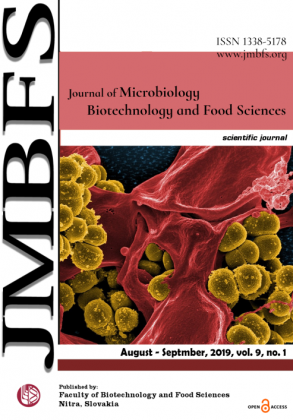FISSION YEAST SCHIZOSACCHAROMYCES POMBE AS A MODEL SYSTEM FOR ULTRASTRUCTURAL INVESTIGATIONS USING TRANSMISSION ELECTRON MICROSCOPY
DOI:
https://doi.org/10.15414/jmbfs.2019.9.1.160-165Keywords:
Schizosaccharomyces pombe; model system; ultrastructure; transmission electron microscopy; sample preparationAbstract
The unicellular fission yeast Schizosaccharomyces pombe (S. pombe) has become a prominent model system to elucidate a various range of biological processes which are highly conserved in mammalian cells. Ultrastructure of the cells related to the organelle morphology is useful in the generation of the comprehensive overview of the cell function. Transmission electron microscopy provides a unique tool to study cell architecture under physiological conditions, as well as ultrastructural changes of the cells due to toxic or beneficial effects of diverse additives. In recent years, S. pombe has also proved to be a suitable cell system for transmission electron microscopy investigations. In the current study, general features of S. pombe are described. In addition, conventional specimen preparation technique and the important discoveries of cell architecture emerging from transmission electron microscopy studies of S. pombe are summarized.Downloads
Download data is not yet available.
Downloads
Published
2019-08-01
How to Cite
Ďúranová, H., Požgajová, M., Novotová, M., Lukáč, N., & Kňažická, Z. (2019). FISSION YEAST SCHIZOSACCHAROMYCES POMBE AS A MODEL SYSTEM FOR ULTRASTRUCTURAL INVESTIGATIONS USING TRANSMISSION ELECTRON MICROSCOPY. Journal of Microbiology, Biotechnology and Food Sciences, 9(1), 160–165. https://doi.org/10.15414/jmbfs.2019.9.1.160-165
Issue
Section
Biotechnology
License
Copyright (c) 2019 Hana Ďúranová, Miroslava Požgajová, Marta Novotová, Norbert LukáÄ, Zuzana Kňažická

This work is licensed under a Creative Commons Attribution 4.0 International License.
All papers published in the Journal of Microbiology, Biotechnology and Food Sciences are published under a CC-BY licence (CC-BY 4.0). Published materials can be shared (copy and redistribute the material in any medium or format) and adapted (remix, transform, and build upon the material for any purpose, even commercially) with specifying the author(s).





